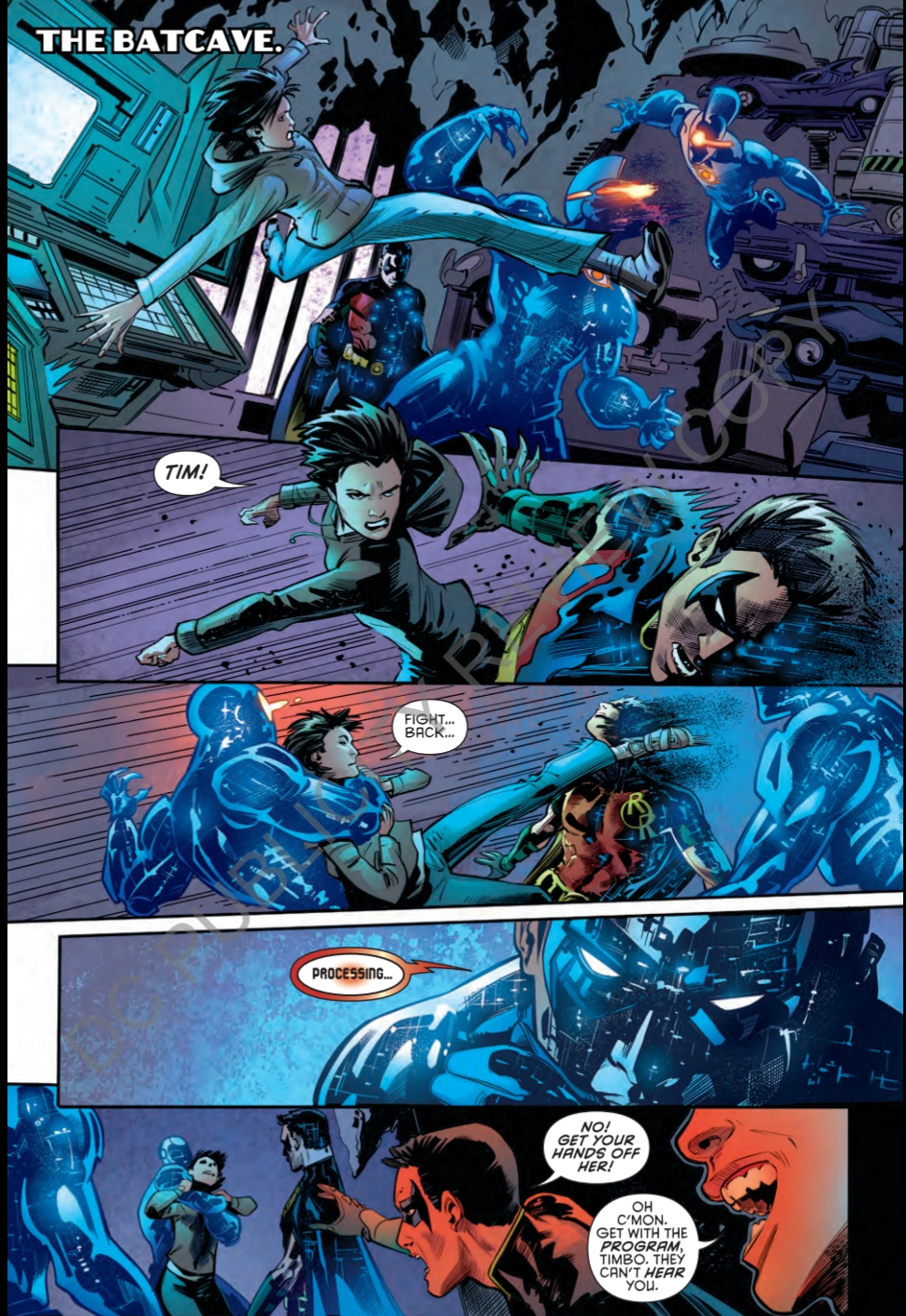Detective Comics #979 // Review
Writer James Tynion IV continues his master class dissertation on the character of
Tim Drake (Red Robin) in Detective Comics #979, Part Four of “Batmen Eternal,” with the assistance of artist Philippe Briones. Despite having been shuffled off to explore Hypertime under a new moniker, Savior, several months prior in Superman #38, the influence of Tim’s future counterpart from the dark Titans Tomorrow timeline is still felt heavily, both in protagonist Tim’s misgivings and in machinations of the villainous Ulysses Hadrian Armstrong, known as “The General.”
Armstrong was able to retrieve remnants of future Tim’s Batman costume, which not only possessed access to OMAC technology, but also extensive files spanning the previous owner’s sad and sordid history. Mentally and physically trapping him inside an OMAC drone, Ulysses tortures Tim with traumatic events experienced by his future counterpart, in an attempt to push present day Tim over the edge into becoming the totalitarian-future iteration, which he fears is his destiny.
Artist Philippe Briones, whose contributions to Detective Comics were last seen five issues prior, performs exemplary work, with dynamic panels, commendable use of cool colors, and creative layouts. In one memorably spectacular spread, a recently captured and disoriented Red Robin is shown coming to terms with the nature of his predicament, learning he has been ensnared by The General and that the prison in which he is being kept resides within his own mind. To symbolize Red Robin’s confinement, Briones draws Drake in a rectangular panel, which copies the cell Tim had previously been jailed in by Jor-El (Mr. Oz). Conjoined to Drake’s cell are two others, in which different perspective shots of The General can be seen, illustrating how Tim is trapped in his head with The General, and that no matter where he turns in his current realm, he will not be able to escape his captor. In the same spread, Briones attempts to disorient the reader in a manner similar to how Tim too is perplexed on the pages, by distorting the art and dialogue away from traditionally structured panels to a point where the reader needs to turn the page clockwise and back again to be able to read and understand what is being conveyed in the spread. The generally disjointed nature of the panels, and use of The General striding amidst panels, in the gutter, gives it an illusive and chimerical quality, emphasising both Drake and the reader’s departure from the recognizable. On standard, non-splash, pages, Philippe accents action scenes with jagged, angular panels, that often overlap at points, bleeding into each other, amplifying the action’s intensity, and speeding up transition through the pages.
As he has done throughout his Detective Comics run, Tynion IV brings together various elements of Tim Drake’s published past while placing emphasis on his primary character flaw. As highlighted back in issue #975, from the character’s inception, Tim Drake has been principally driven by the ideology of Batman, and his mission to make both Bruce and his crusade more effective. Tynion IV has toyed with Tim’s idealism, previously testing it through betrayal by mentor and inspiration, Batman; abandonment by girlfriend, Stephanie Brown (Spoiler); and additional betrayal from Batwoman, who recently murdered a reforming Clayface, in cold mud. These tribulations compounded with Tim’s already deteriorating internal demeanor following confrontation of his future counterpart, making him more susceptible to influences of The General and the twisted perspectives of his future self.
From Detective Comics #975
The conclusion of this issue combines two of Tim’s darkest future timelines, Titans Tomorrow and Futures End, into a nightmarish present where Tim has both transformed into the tyrant he feared to be his inevitable fate, and willingly become a part of the OMAC collective, which an alternate version of him fought, in multiple timelines, to prevent from eradicating mankind. Drawing not only from these tangential dystopian tales, but from the depths of Drake’s prime canon, Tynion IV makes “Batmen Eternal” more powerful because of the importance placed on characters established during Chuck Dixon’s monumental initial run on Robin, released in the early ‘90s--notably Ulysses Armstrong, and Stephanie Brown, whose importance in upcoming issues is foreshadowed in #979’s closing pages.
This issue succeeds in paying-off a number of previously established story elements, particularly those affecting Tim Drake, while progressing the story to an unseen place that tests the characters and captivates the reader. The key driver in this issue is the dialogue, particularly between Tim and Ulysses. Though fairly simplistic, the dialogue showcases Tim’s internal struggles, while properly establishing Ulysses’ Machiavellian ways. Dialogue between secondary characters in this issue’s plot is sparse and straight to the point, allowing for an emphasis on action, a smooth narrative flow, and more time spent on the issue’s primary plot. Meant to be an emotional zenith for Drake, the issue accomplishes its goal of pushing Tim past the tipping point, without compromising the character’s integrity, and while amping up the angst.
Detective Comics #979 marks another remarkable chapter in James Tynion IV’s epic, overarching tale of Gotham, bringing a number of story threads together as the story nears its end. Strong character insight and development is seen, as well as large strides in the narrative pace. In congruence with the acceleration of events, the interior art has also become more energised and action-oriented. This issue marks a climactic turning point in Tynion IV’s tenure, and is an absolute must-read.










